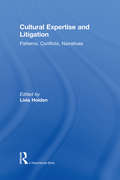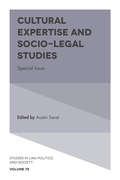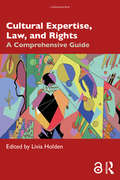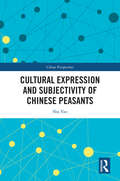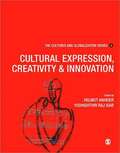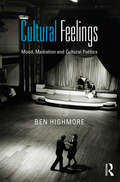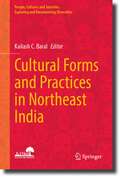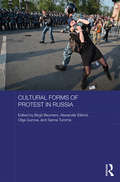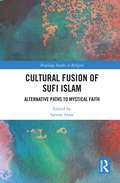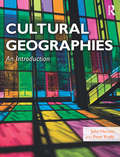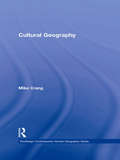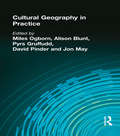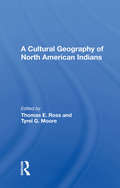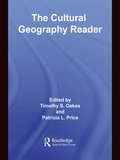- Table View
- List View
Cultural Expertise and Litigation: Patterns, Conflicts, Narratives
by Livia HoldenCultural Expertise and Litigation addresses the role of social scientists as a source of expert evidence, and is a product of their experiences and observations of cases involving litigants of South Asian origin. What is meant in court by "culture," "custom" and "law"? How are these concepts understood by witnesses, advocates, judges and litigants? How far are cross-cultural understandings facilitated - or obscured - in the process? What strategies are adopted? And which ones turn out to be successful in court? How is cultural understanding – and misunderstanding – produced in these circumstances? And how, moreover, do the decisions in these cases not only reflect, but impact, upon the law and the legal procedure? Cultural Expertise and Litigation addresses these questions, as it elicits the patterns, conflicts and narratives that characterize the legal role of social scientists in a variety of de facto plural settings – including immigration and asylum law, family law, citizenship law and criminal law.
Cultural Expertise and Litigation: Patterns, Conflicts, Narratives
by Livia HoldenCultural Expertise and Litigation addresses the role of social scientists as a source of expert evidence, and is a product of their experiences and observations of cases involving litigants of South Asian origin. What is meant in court by "culture," "custom" and "law"? How are these concepts understood by witnesses, advocates, judges and litigants? How far are cross-cultural understandings facilitated - or obscured - in the process? What strategies are adopted? And which ones turn out to be successful in court? How is cultural understanding – and misunderstanding – produced in these circumstances? And how, moreover, do the decisions in these cases not only reflect, but impact, upon the law and the legal procedure? Cultural Expertise and Litigation addresses these questions, as it elicits the patterns, conflicts and narratives that characterize the legal role of social scientists in a variety of de facto plural settings – including immigration and asylum law, family law, citizenship law and criminal law.
Cultural Expertise and Socio-Legal Studies: Special Issue (Studies in Law, Politics, and Society #78)
by Austin SaratThis special issue of Studies in Law, Politics, and Society aims to foster a dialogue that is inclusive, constructive, and innovative in order to lay the basis for evaluating the usefulness and impact of cultural expertise in modern litigation. It investigates the scope of cultural expertise as a new socio-legal concept that broadly concerns the use of social sciences in connection with rights and the solution of conflicts. While the definition of cultural expertise is new, the conflicts it applies to are not, and these range from criminal law to civil law, including international human rights. In this special issue, socio-legal scientists with interdisciplinary backgrounds scrutinize the applicability of the notion of cultural expertise in Europe and the rest of the World. Cases include murder, female genital mutilation, earthquake claims, Islamic law, underage marriages, child custody, adoption, land rights, and asylum. The authors debate on a variety of themes, such as legal pluralism, ethnicity, causal determinism, reification of culture, and the "culturalization" of defendants. The volume concludes with an overview of the ethical implications of the definition of cultural expertise and suggestions for a way forward.
Cultural Expertise and Socio-Legal Studies: Special Issue (Studies in Law, Politics, and Society #78)
by Austin SaratThis special issue of Studies in Law, Politics, and Society aims to foster a dialogue that is inclusive, constructive, and innovative in order to lay the basis for evaluating the usefulness and impact of cultural expertise in modern litigation. It investigates the scope of cultural expertise as a new socio-legal concept that broadly concerns the use of social sciences in connection with rights and the solution of conflicts. While the definition of cultural expertise is new, the conflicts it applies to are not, and these range from criminal law to civil law, including international human rights. In this special issue, socio-legal scientists with interdisciplinary backgrounds scrutinize the applicability of the notion of cultural expertise in Europe and the rest of the World. Cases include murder, female genital mutilation, earthquake claims, Islamic law, underage marriages, child custody, adoption, land rights, and asylum. The authors debate on a variety of themes, such as legal pluralism, ethnicity, causal determinism, reification of culture, and the "culturalization" of defendants. The volume concludes with an overview of the ethical implications of the definition of cultural expertise and suggestions for a way forward.
Cultural Expertise, Law, and Rights: A Comprehensive Guide
by Livia HoldenCultural Expertise, Law, and Rights introduces readers to the theory and practice of cultural expertise in the resolution of conflicts and the claim of rights in diverse societies. Combining theory and case-studies of the use of cultural expertise in real situations, and in a great variety of fields, this is the first book to offer a comprehensive examination of the field of cultural expertise: its intellectual orientations, practical applications and ethical implications. This book engages an extensive and interdisciplinary variety of topics – ranging from race, language, sexuality, Indigenous rights and women’s rights to immigration and asylum laws, international commercial arbitration and criminal law. It also offers a truly global perspective covering cultural expertise in Africa, Asia, Australia, Europe, Latin America, the Middle East and North America. Finally, the book offers theoretical and practical guidance for the ethical use of cultural expert knowledge. This is an essential volume for teachers and students in the social sciences – especially law, anthropology, and sociology – and members of the legal professions who engage in cross-cultural dispute resolution, asylum and migration, private international law and other fields of law in which cultural arguments play a role. The Open Access version of this book, available at www.taylorfrancis.com, has been made available under a Creative Commons Attribution-Non Commercial-No Derivatives 4.0 license.
Cultural Expertise, Law, and Rights: A Comprehensive Guide
by Livia HoldenCultural Expertise, Law, and Rights introduces readers to the theory and practice of cultural expertise in the resolution of conflicts and the claim of rights in diverse societies. Combining theory and case-studies of the use of cultural expertise in real situations, and in a great variety of fields, this is the first book to offer a comprehensive examination of the field of cultural expertise: its intellectual orientations, practical applications and ethical implications. This book engages an extensive and interdisciplinary variety of topics – ranging from race, language, sexuality, Indigenous rights and women’s rights to immigration and asylum laws, international commercial arbitration and criminal law. It also offers a truly global perspective covering cultural expertise in Africa, Asia, Australia, Europe, Latin America, the Middle East and North America. Finally, the book offers theoretical and practical guidance for the ethical use of cultural expert knowledge. This is an essential volume for teachers and students in the social sciences – especially law, anthropology, and sociology – and members of the legal professions who engage in cross-cultural dispute resolution, asylum and migration, private international law and other fields of law in which cultural arguments play a role. The Open Access version of this book, available at www.taylorfrancis.com, has been made available under a Creative Commons Attribution-Non Commercial-No Derivatives 4.0 license.
Cultural Expression and Subjectivity of Chinese Peasants (China Perspectives)
by Sha YaoAs the famous sociologist Fei Xiaotong argued, “the real life of most Chinese can only be seen in the villages.” Peasants not only comprise a significant part of the Chinese population but represent a distinctive culture and one that is expressed in its own particular way. This makes for an important area of study for scholars in communication studies. This volume investigates how Chinese peasants express their culture and adapt to social change. The author’s research consists of participant observation and interviews of shadow puppetry artists in Guanzhong, China, illustrating how peasant artists have adapted to the historical and social changes since the founding of the People’s Republic of China. He discovers that Chinese peasants integrate urban popular culture with their own aesthetic criteria, even if the mainstream discourse of the Chinese community overlooks the subjectivity of peasants. He goes on to put forwards a creative analytical framework for the studies of the dynamics of “subject-time-space.” Scholars and students of anthropology, sociology, and communication studies, especially rural communication studies, will find this an ideal case study.
Cultural Expression and Subjectivity of Chinese Peasants (China Perspectives)
by Sha YaoAs the famous sociologist Fei Xiaotong argued, “the real life of most Chinese can only be seen in the villages.” Peasants not only comprise a significant part of the Chinese population but represent a distinctive culture and one that is expressed in its own particular way. This makes for an important area of study for scholars in communication studies. This volume investigates how Chinese peasants express their culture and adapt to social change. The author’s research consists of participant observation and interviews of shadow puppetry artists in Guanzhong, China, illustrating how peasant artists have adapted to the historical and social changes since the founding of the People’s Republic of China. He discovers that Chinese peasants integrate urban popular culture with their own aesthetic criteria, even if the mainstream discourse of the Chinese community overlooks the subjectivity of peasants. He goes on to put forwards a creative analytical framework for the studies of the dynamics of “subject-time-space.” Scholars and students of anthropology, sociology, and communication studies, especially rural communication studies, will find this an ideal case study.
Cultural Expression, Creativity and Innovation (PDF)
by Helmut K Anheier'In the globalization 'game' there are no absolute winners and losers. Neither homogenisation nor diversity can capture its contradictory movement and character. The essays and papers collected here offer, from a variety of perspectives, a rich exploration of creativity and innovation, cultural expressions and globalization. This volume of essays, in all their diversity of contents and theoretical perspectives, demonstrates the rich value of this paradoxical, oxymoronic approach' - Stuart Hall, Emeritus Professor of Sociology at the Open University. Volume 3 of the Cultures amp; Globalization series, Creativity and Innovations , explores the interactions between globalization and the forms of cultural expression that are their basic resource. Bringing together over 25 high-profile authors from around the world, this volume addresses such questions as: What impacts does globalization have on cultural creativity and innovation? How is the evolving world 'map' of creativity related to the drivers and patterns of globalization? What are the relationships between creative acts, clusters, genres or institutions and cultural diversity? The volume is an indispensable reference tool for all scholars and students of contemporary arts and culture.
Cultural Feelings: Mood, Mediation and Cultural Politics
by Ben HighmoreCultural Feelings: Mood, Mediation and Cultural Politics sets out to examine the role of feelings and mood in the production of social and cultural experience. By returning to the work of Raymond Williams, and informed by recent ‘affect theory’, it treats feeling as a foundational term for cultural studies. Ben Highmore argues that feelings are political and cultural forms that orchestrate our encounters with the world. He utilises a range of case studies from twentieth-century British culture, focusing in particular on Home Front morale during the Blitz, the experiences of Caribbean migration in the post-war decades, the music of post-punk bands in the late 1970s and early 1980s, and more recent ‘state of the nation’ film and television, including Our Friends in the North and This is England. He finds evidence in oral history, in films, photographs, television, novels, music, policy documents, and journalism. Through these sources, this book tells a vivid and compelling story of our most recent history and argues that the urgent task for a progressive cultural politics will require the changing of moods as well as minds. Cultural Feelings is essential reading for students and researchers with an interest in affect theory, emotion and culture.
Cultural Feelings: Mood, Mediation and Cultural Politics
by Ben HighmoreCultural Feelings: Mood, Mediation and Cultural Politics sets out to examine the role of feelings and mood in the production of social and cultural experience. By returning to the work of Raymond Williams, and informed by recent ‘affect theory’, it treats feeling as a foundational term for cultural studies. Ben Highmore argues that feelings are political and cultural forms that orchestrate our encounters with the world. He utilises a range of case studies from twentieth-century British culture, focusing in particular on Home Front morale during the Blitz, the experiences of Caribbean migration in the post-war decades, the music of post-punk bands in the late 1970s and early 1980s, and more recent ‘state of the nation’ film and television, including Our Friends in the North and This is England. He finds evidence in oral history, in films, photographs, television, novels, music, policy documents, and journalism. Through these sources, this book tells a vivid and compelling story of our most recent history and argues that the urgent task for a progressive cultural politics will require the changing of moods as well as minds. Cultural Feelings is essential reading for students and researchers with an interest in affect theory, emotion and culture.
Cultural Forms and Practices in Northeast India (People, Cultures and Societies: Exploring and Documenting Diversities)
by Kailash C. BaralThe present book examines cultural diversities of Northeast India. The sixteen essays included in the volume cover various aspects of cultural forms and their practices among the communities of Northeast. The present volume is expected to serve as a bridge between vanishing cultural forms and their commodification, on the one hand, and their cultural ritual origins, evolution and significance in identity formation, on the other. The book analyses continuity of cultural forms, their representations and often their reinventions under globalisation. Further, the book underlines historical forces such as colonialism and religious conversion that have transformed communities and their cultural practices. Yet some of the pre-colonial, ritual-performative traditions hold on. Through insightful analyses, this book offers an informed view of the region’s historical, ethnic and cultural practices. It is expected that the volume will be useful for scholars and students interested in Northeast studies.
Cultural Forms of Protest in Russia (Routledge Contemporary Russia and Eastern Europe Series)
by Birgit Beumers Alexander Etkind Olga Gurova Sanna TuromaAlongside the Arab Spring, the 'Occupy' anti-capitalist movements in the West, and the events on the Maidan in Kiev, Russia has had its own protest movements, notably the political protests of 2011–12. As elsewhere in the world, these protests had unlikely origins, in Russia’s case spearheaded by the 'creative class'. This book examines the protest movements in Russia. It discusses the artistic traditions from which the movements arose; explores the media, including the internet, film, novels, and fashion, through which the protesters have expressed themselves; and considers the outcome of the movements, including the new forms of nationalism, intellectualism, and feminism put forward. Overall, the book shows how the Russian protest movements have suggested new directions for Russian – and global – politics.
Cultural Forms of Protest in Russia (Routledge Contemporary Russia and Eastern Europe Series)
by Birgit Beumers Alexander Etkind Olga Gurova Sanna TuromaAlongside the Arab Spring, the 'Occupy' anti-capitalist movements in the West, and the events on the Maidan in Kiev, Russia has had its own protest movements, notably the political protests of 2011–12. As elsewhere in the world, these protests had unlikely origins, in Russia’s case spearheaded by the 'creative class'. This book examines the protest movements in Russia. It discusses the artistic traditions from which the movements arose; explores the media, including the internet, film, novels, and fashion, through which the protesters have expressed themselves; and considers the outcome of the movements, including the new forms of nationalism, intellectualism, and feminism put forward. Overall, the book shows how the Russian protest movements have suggested new directions for Russian – and global – politics.
Cultural Fusion of Sufi Islam: Alternative Paths to Mystical Faith (Routledge Studies in Religion)
by Sarwar AlamIt has been argued that the mystical Sufi form of Islam is the most sensitive to other cultures, being accommodative to other traditions and generally tolerant to peoples of other faiths. It readily becomes integrated into local cultures and they are similarly often infused into Sufism. Examples of this reciprocity are commonly reflected in Sufi poetry, music, hagiographic genres, memoires, and in the ritualistic practices of Sufi traditions. This volume shows how this often-side-lined tradition functions in the societies in which it is found, and demonstrates how it relates to mainstream Islam. The focus of this book ranges from reflecting Sufi themes in the Qur’anic calligraphy to movies, from ideals to everyday practices, from legends to actual history, from gender segregation to gender transgression, and from legalism to spiritualism. Consequently, the international panel of contributors to this volume are trained in a range of disciplines that include religious studies, history, comparative literature, anthropology, and ethnography. Covering Southeast Asia to West Africa as well as South Asia and the West, they address both historical and contemporary issues, shedding light on Sufism’s adaptability. This book sets aside conventional methods of understanding Islam, such as theological, juridical, and philosophical, in favour of analysing its cultural impact. As such, it will be of great interest to all scholars of Islamic Studies, the Sociology of Religion, Religion and Media, as well as Religious Studies and Area Studies more generally.
Cultural Fusion of Sufi Islam: Alternative Paths to Mystical Faith (Routledge Studies in Religion)
by Sarwar AlamIt has been argued that the mystical Sufi form of Islam is the most sensitive to other cultures, being accommodative to other traditions and generally tolerant to peoples of other faiths. It readily becomes integrated into local cultures and they are similarly often infused into Sufism. Examples of this reciprocity are commonly reflected in Sufi poetry, music, hagiographic genres, memoires, and in the ritualistic practices of Sufi traditions. This volume shows how this often-side-lined tradition functions in the societies in which it is found, and demonstrates how it relates to mainstream Islam. The focus of this book ranges from reflecting Sufi themes in the Qur’anic calligraphy to movies, from ideals to everyday practices, from legends to actual history, from gender segregation to gender transgression, and from legalism to spiritualism. Consequently, the international panel of contributors to this volume are trained in a range of disciplines that include religious studies, history, comparative literature, anthropology, and ethnography. Covering Southeast Asia to West Africa as well as South Asia and the West, they address both historical and contemporary issues, shedding light on Sufism’s adaptability. This book sets aside conventional methods of understanding Islam, such as theological, juridical, and philosophical, in favour of analysing its cultural impact. As such, it will be of great interest to all scholars of Islamic Studies, the Sociology of Religion, Religion and Media, as well as Religious Studies and Area Studies more generally.
Cultural Geographies: An Introduction
by John Horton Peter KraftlCultural geography is a major, vibrant subdiscipline of human geography. Cultural geographers have done some of the most important, exciting and thought-provokingly zesty work in human geography over the last half-century. This book exists to provide an introduction to the remarkably diverse, controversial, and sometimes-infuriating work of cultural geographers. The book outlines how cultural geography in its various forms provides a rich body of research about cultural practices and politics in diverse contexts. Cultural geography offers a major resource for exploring the importance of cultural materials, media, texts and representations in particular contexts and is one of the most theoretically adventurous subdisciplines within human geography, engaging with many important lines of social and cultural theory. The book has been designed to provide an accessible, wide-ranging and thought-provoking introduction for students studying cultural geography, or specific topics within this subdiscipline. Through a wide range of case studies and learning activities, it provides an engaging introduction to cultural geography.
Cultural Geographies: An Introduction
by John Horton Peter KraftlCultural geography is a major, vibrant subdiscipline of human geography. Cultural geographers have done some of the most important, exciting and thought-provokingly zesty work in human geography over the last half-century. This book exists to provide an introduction to the remarkably diverse, controversial, and sometimes-infuriating work of cultural geographers. The book outlines how cultural geography in its various forms provides a rich body of research about cultural practices and politics in diverse contexts. Cultural geography offers a major resource for exploring the importance of cultural materials, media, texts and representations in particular contexts and is one of the most theoretically adventurous subdisciplines within human geography, engaging with many important lines of social and cultural theory. The book has been designed to provide an accessible, wide-ranging and thought-provoking introduction for students studying cultural geography, or specific topics within this subdiscipline. Through a wide range of case studies and learning activities, it provides an engaging introduction to cultural geography.
Cultural Geography
by Mike CrangFirst Published in 1998. Routledge is an imprint of Taylor & Francis, an informa company.
Cultural Geography
by Mike CrangFirst Published in 1998. Routledge is an imprint of Taylor & Francis, an informa company.
CULTURAL GEOGRAPHY IN PRACTICE
by Miles Ogborn Alison Blunt Pyrs Gruffudd David PinderCultural Geography in Practice provides an innovative and accessible approach to the sources, theories and methods of cultural geography. Written by an international team of prominent cultural geographers, all of whom are experienced researchers, this book is a fully illustrated guide to methodological approaches in cultural geography. In order to demonstrate the practice of cultural geography each chapter combines the following features:·Practical instruction in using one of the main methods of cultural geography (e.g. interviewing, interpreting texts and visual images, participatory methods)·An overview of a key area of concern in cultural geography (e.g. the body, national identity, empire, marginality)·A nuts and bolts description of the actual application of the theories and methods within a piece of researchWith the addition of boxed definitions of key concepts and descriptions of research projects by students who devised and undertook them, Cultural Geography in Practice is an essential manual of research practice for both undergraduate and graduate geography students.
CULTURAL GEOGRAPHY IN PRACTICE
by Miles Ogborn Alison Blunt David Pinder Pyrs GruffuddCultural Geography in Practice provides an innovative and accessible approach to the sources, theories and methods of cultural geography. Written by an international team of prominent cultural geographers, all of whom are experienced researchers, this book is a fully illustrated guide to methodological approaches in cultural geography. In order to demonstrate the practice of cultural geography each chapter combines the following features:·Practical instruction in using one of the main methods of cultural geography (e.g. interviewing, interpreting texts and visual images, participatory methods)·An overview of a key area of concern in cultural geography (e.g. the body, national identity, empire, marginality)·A nuts and bolts description of the actual application of the theories and methods within a piece of researchWith the addition of boxed definitions of key concepts and descriptions of research projects by students who devised and undertook them, Cultural Geography in Practice is an essential manual of research practice for both undergraduate and graduate geography students.
A Cultural Geography Of North American Indians
by Thomas E. RossThis book focuses on the effects of interaction between Indian and non-Indian peoples and on the complex relationships between Indians and their environments. It presents information for an accurate assessment of whether North American Indians can survive as a distinct culture. .
A Cultural Geography Of North American Indians
by Thomas E. Ross Tyrel G. MooreThis book focuses on the effects of interaction between Indian and non-Indian peoples and on the complex relationships between Indians and their environments. It presents information for an accurate assessment of whether North American Indians can survive as a distinct culture. .
The Cultural Geography Reader
by Timothy Oakes Patricia L. PriceThe Cultural Geography Reader draws together fifty-two classic and contemporary abridged readings that represent the scope of the discipline and its key concepts. Readings have been selected based on their originality, accessibility and empirical focus, allowing students to grasp the conceptual and theoretical tools of cultural geography through the grounded research of leading scholars in the field. Each of the eight sections begins with an introduction that discusses the key concepts, its history and relation to cultural geography and connections to other disciplines and practices. Six to seven abridged book chapters and journal articles, each with their own focused introductions, are also included in each section. The readability, broad scope, and coverage of both classic and contemporary pieces from the US and UK makes The Cultural Geography Reader relevant and accessible for a broad audience of undergraduate students and graduate students alike. It bridges the different national traditions in the US and UK, as well as introducing the span of classic and contemporary cultural geography. In doing so, it provides the instructor and student with a versatile yet enduring benchmark text.
